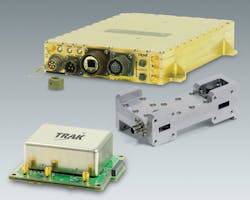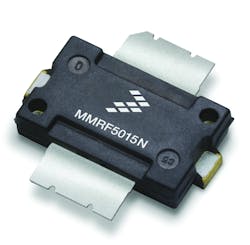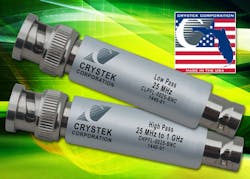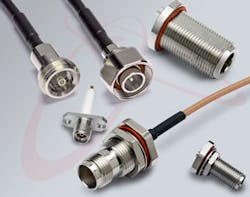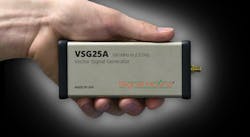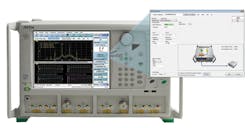This file type includes high resolution graphics and schematics when applicable.
New products overwhelmed many of the more than 8,600 visitors at the recent 2015 IEEE International Microwave Symposium (IMS) in Phoenix, Ariz., with hundreds of exhibitors (at more than 900 booths) unveiling their latest designs in hardware, software, and test equipment. Here’s a roundup of just a few of the many new offerings seen at IMS, as the industry continues to extend to a growing number of application areas.
As an example of a building-block product designed to reach across industries, Qorvo unveiled a family of plastic-packaged gallium-nitride (GaN) power transistors for military radios and radar systems. The input ports are impedance matched to 50 Ω to simplify use. The +32-VDC transistors are supplied in 3×3 mm packages and usable from 30 MHz to 3 GHz. The product line includes the model TGF2965 with 6 W output power (at 3-dB compression) at 2 GHz and model TGF3015-SM with 11 W output power (at 3-dB compression) at 2.4 GHz.
Also for commercial and military applications, TRAK Microwave displayed communications subassemblies and network timing modules for terrestrial and satellite-communications (satcom) applications (Fig. 1). The lineup included the model MFC147 block upconverter for satcom use from 13.75 to 14.50 GHz. Powered by a 25-W GaN amplifier, the upconverter features extensive surface-mount-technology (SMT) components and a rugged design well suited for airborne environments. TRAK also offered a dual-band Ku-band frequency downconverter for very-small-aperture-terminal (VSAT) applications. The downconverter translates bands of 10.7 to 11.7 GHz and 11.7 to 12.75 GHz to intermediate frequencies (IFs) of 950 to 1950 MHz and 1100 to 1250 MHz, respectively, with digital band selection.
Still showing its knack for high-level integration in small spaces, Analog Devices introduced its model ADF5904 monolithic microwave integrated circuit (MMIC). The four-channel, 24-GHz receiver downconverter fits into a 5 mm × 5 mm plastic LFCSP housing. Each of the receiver downconverter’s four on-chip receive channels employs a single-ended connection to an antenna for simple transmission-line design and circuit layouts for receiver systems. The MMIC downconverter achieves 22-dB receive channel gain with 10-dB noise figure across a 250-MHz bandwidth. It consumes only 0.5 mW power with all four channels in operation. The packaged MMIC even includes a temperature sensor to help calibrate performance over wide operating temperature ranges.
Also on hand at IMS was Freescale Semiconductor, which launched a pair of wideband GaN transistors in an advanced plastic package. The model OM-270 package, available in two- and eight-lead configurations, extends the firm’s plastic packaging technology to a miniature outline with GaN compatibility. The model MMRF5015N GaN transistor (Fig. 2) is capable of 100-W CW output power with 12-dB gain across a wide bandwidth of 200 to 2500 MHz. The +50-VDC device provides 40% efficiency over that bandwidth. The model MMRF5011N GaN transistor delivers 10-W CW output power from 20 to 2600 MHz when operating from a +28-VDC supply. The company also introduced its first GaN power transistor for cellular base station, the model A2G22S160-01S, a device capable of supporting 30 to 40 W amplifiers.
Several plug-and-play evaluation tools from NXP Semiconductors N.V. were introduced in support of the company’s latest (ninth) generation of laterally diffused metal oxide semiconductor (LDMOS) power transistors. The evaluation tools, which allow developers to use codes from National Instruments’ LabVIEW software for final programming, include a package for S-band radar applications and a power amplifier package that is said to provide a 30% performance improvement due to enhanced thermal management.
Offering its latest BNC-equipped lowpass filters (LPFs) and highpass filters (HPFs) was Crystek Corp. The CLPFL line of BNC LPFs includes models with passbands extending to 90 MHz, including DC to 10 MHz, DC to 25 MHz, DC to 50 MHz, and DC to 90 MHz. These LPFs achieve filtering with a ninth-order Chebyshev filter response with high out-of-band rejection. The CHPFL series of BNC-based HPFs incorporate a seventh-order Chebyshev filter response. The HPF line includes the model CHPFL-0025-BNC HPF with passband of 25 MHz to 1 GHz. All of the filters (Fig. 3) are rated to handle input power levels to +36 dBm (4 W) and operating temperatures from -40°C to +85°C.
San-tron addressed the growing interest in minimizing passive intermodulation (PIM) in communications systems with its SRX line of low-PIM coaxial connectors, adapters, and cable assemblies (Fig. 4). The firm claimed typical PIM performance of -158 dBc for cable assemblies terminated with SMA and Type N coaxial connectors and PIM performance as low as -168 dBc with 0.141-in.diameter flexible cable terminated with eSeries 7/16 connectors. Some of the SRX cable assemblies were available with fire retardation to meet the requirements of in-building applications, such as in distributed antenna systems (DAS).
This file type includes high resolution graphics and schematics when applicable.
Innovative Software Launches
This file type includes high resolution graphics and schematics when applicable.
On the software wide, ANSYS intrigued visitors with the latest 3D electromagnetic (EM) simulation capabilities in its High Frequency Structure Simulator (HFSS) software. Show attendees learned how this popular simulation software uses 3D layout and optimization techniques to speed and improve the accuracy of circuit design (a video is also available on the company’s website). The latest version of HFSS employs advanced solvers, including method-of-moments (MoMs) and finite-element-model (FEM) solvers, to derive solutions for high-frequency circuits and components, including a plethora of 3D effects.
For those in search of new measurement solutions at the 2015 IMS, Signal Hound impressed visitors with its cost-effective approach to test equipment, notably with its model VSG25A vector signal generator (Fig. 5). The USB-powered and controlled signal source covers a frequency range of 100 MHz to 2.5 GHz and can fit in a shirt pocket. It provides output levels from -40 to +10 dBm and a modulation bandwidth as wide as 100 MHz and is priced at only $495. The signal generator delivers a wide range of digital modulation formats, including those based on phase shift keying (PSK) and quadrature amplitude modulation (QAM), as well as traditional AM, FM, and pulse modulation.
More improvements to its test instruments were on the way from Anritsu Co., which offered, intermodulation-distortion (IMD) options for its VectorStar vector network analyzers (VNAs). The capabilities include the new IMDView software (Fig. 6) with straightforward graphical user interface (GUI) for simple IMD measurements on amplifiers. The analyzers also offer an internal RF combiner/switch option that allows single-connection IMD measurements without rewiring a measurement setup. The IMDView software allows operators to modify key parameters while checking the test results, to quickly determine optimum operating conditions for an amplifier under test.
Also from Anritsu is the MA24208A/MA24218A line of USB power sensors for true root-mean-square (RMS) power measurements from 10 MHz to 18 GHz, with the help of a PC. The USB power sensors read levels from -60 to +20 dBm with damage protection to 1 W (+30 dBm) for continuous-wave (CW) power inputs and as high as +34 dBm for peak levels of 10 μs or less. The power sensors can be used with any Windows-based PC running the PowerXpert measurement software. The sensors are also compatible with most of Anritsu’s handheld instruments, including its Spectrum Master spectrum analyzers and Cell Master base-station analyzers.
Another IMS exhibitor with big news was Eastern OptX, which introduced its Series 8000 test system, a multiple-channel, bidirectional radio path replicator for testing multiple RF/microwave radios or wireless systems simultaneously over different propagation paths. The system employs fiber-optic delay-line technology to replicate a wide range of propagation paths and provides a versatile RF interface that supports testing of all wireless standards, including Bluetooth, WiMAX, GSM, and LTE cellular.
This file type includes high resolution graphics and schematics when applicable.
About the Author
Jack Browne
Technical Contributor
Jack Browne, Technical Contributor, has worked in technical publishing for over 30 years. He managed the content and production of three technical journals while at the American Institute of Physics, including Medical Physics and the Journal of Vacuum Science & Technology. He has been a Publisher and Editor for Penton Media, started the firm’s Wireless Symposium & Exhibition trade show in 1993, and currently serves as Technical Contributor for that company's Microwaves & RF magazine. Browne, who holds a BS in Mathematics from City College of New York and BA degrees in English and Philosophy from Fordham University, is a member of the IEEE.
